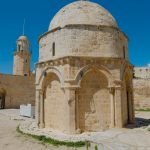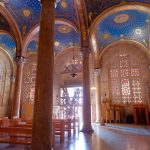The posts from 20-28 March 2014 were originally posts formatted for Tumblr. Click here to see the original blog.
Mount of Olives
The Mount of Olives is a small rise on the edge of East Jerusalem with a great drop from the 1000m height of the city towards the Dead Sea further east and 400m below sea level. You can see the Dead Sea from the top. The mount also has a commanding view of the city if you look west. Presumably it was once full of olive trees. Now it is 50% cemetery.
Our group of Christians and Muslims took to an olive grove near the crest of the ridge to reflect on the past few days. It was clear that we were still not ready to ask really difficult questions of each other but that relationships had grown with a deeper understanding and respect. Perhaps reaching out across the faiths is after all about relationships before anything else. In Jerusalem it is clear that there is a deep level of interfaith friendship between Christian and Muslim (at least in some sectors of society) that could be a real example to the world. Our group had mainly been exposed to Palestinians that the British would think of as the middle classes and it would be interesting to test out how relationships work at other levels of society here another time. But this is a nation that is anxious and fearful. And the fearfulness draws a hard boundary between Jew and Arab that very few yet seem to be reaching across. It is difficult to see hope where there is an imbalance of power and force, but the relationships that the Christians and Muslims we met have forged is somewhere that hope can be found here. I pray that this is a source of spreading hope and not one that will be extinguished. It is a delicate flower and, as Arab Christians flee the land, it only becomes more fragile.
Pictures above:
- Top: The Mount of Olives as seen from the Muslim Cemetery just below Haram al-Sharif
- Triptych
Left: Poppies growing in an olive grove
Middle: The Church of the Ascension on the Mount of Olives, now part of a Mosque complex (see the minaret in the background) but open for Christians to worship here – a powerful example of a shared worship space
Right: The modern and Islamic influenced Church of the Agony of Christ in the Garden of Gethsemane - The golden onions of the Russian Orthodox Church of Mary Magdalene with the Islamic Cemetery in the background.






